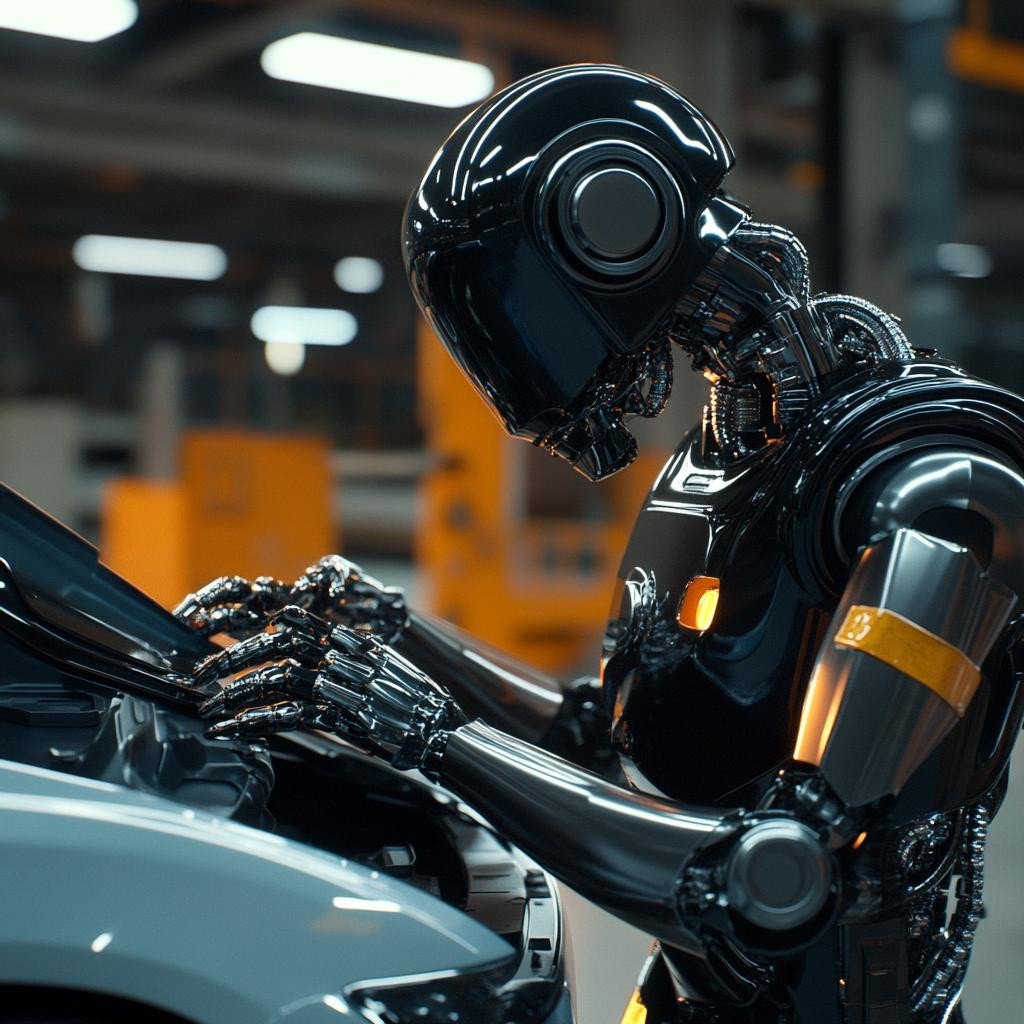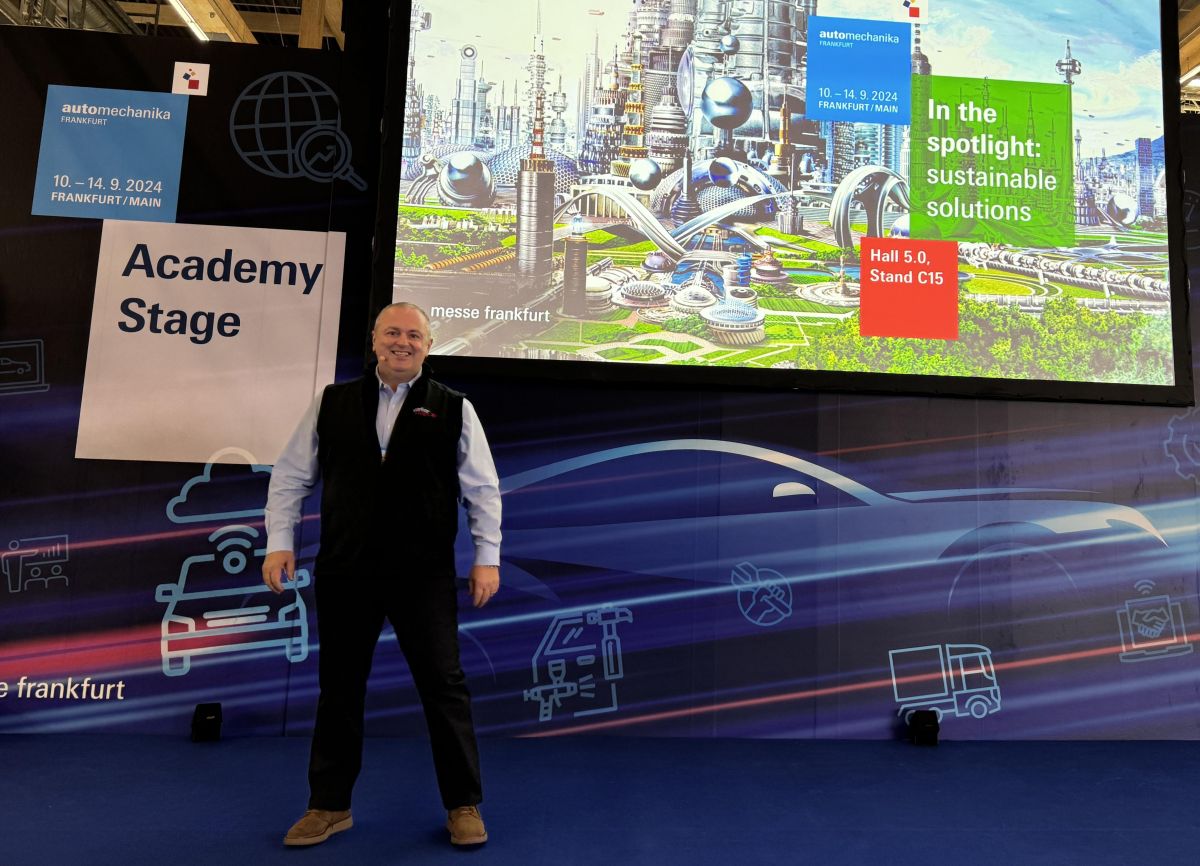Mario Dimovski’s experience working as a 16-year-old plastic repair technician over three decades ago taught him about the importance of innovating to succeed. In his current role as director of circular and repair innovation at The Boyd Group, Dimovski oversees more than 900 collision shops in the U.S. and Canada. He is dedicated to advancing the collision repair industry and focuses on sustainability, plastic repairs, the evolving nature of work and digital transformation, especially in automation and artificial intelligence (AI) platforms.
In addition to his role at Boyd Group, Dimovski is a member of Auto Additive’s 3D Printing Advisory Council and is a global ambassador for the International Bodyshop Industry Symposium (IBIS).
At the recent Automechanika Frankfurt show in Germany, Dimovski presented on “Innovations & Transformation in the Collision Repair Industry.” Dimovski talked about how the industry is transforming and what shops need to know to prepare for the future.
With the fast-paced lifestyle common today, Dimovski said many people are on the run and out of time, both in their personal and professional lives.
They are also reliant on electronic devices and connectivity. “We’ve become a culture of instant gratification and social media is a huge influencer,” he noted.
While shop owners and managers expect new employees to dedicate themselves to hard work and training, he finds many don’t have that level of commitment.
Dimovski recalled when he interviewed prospective employees in the past and asked about their goals, which he found to be ambitious. However, he often notices newcomers lacking focus and patience.
“Everybody wants a pay raise tomorrow and be a boss tomorrow,” he said.
He said this mindset is hampering the industry. At the same time, new digital careers -- such as professional gamers -- are evolving. “This is forcing our industry and others to transform,” he explained.
Technology & Automation
Dimovski discussed the future impact innovations in technology and automation will likely have on the collision repair industry. “There is a disconnect between where we’re headed and where the collision industry is today,” he noted.
To help address that disconnect, he said the industry will need to find ways to transfer knowledge to technicians.
He encouraged the industry to watch a video about the Audi Smart Factory, illustrating how some OEMs are using augmented reality and AI to fix cars. In contrast, most collision repair facilities are unfamiliar with these methods or technologies.
“The actual push for us to transform is being led by the OEMs,” said Dimovski.
He pointed to the increase in electric vehicles (EVs) and cars with autonomous features. “There's an abundance of them, which is forcing us to change our repair methods,” he added.
The use of AI and machine learning are also becoming more commonplace. Although Dimovski uses AI in some instances, such as creating the images he used in his presentation, he acknowledged it can create issues and challenges.
Other technological innovations he mentioned are wearables, like watches, and devices, such as augmented reality glasses.
 Image generated by Midjourney, AI platform.
Image generated by Midjourney, AI platform.
He noted that companies like Tesla are building humanoid robots for home and work that will likely be used in the future. 3D printing technology is on the rise, which he said is a huge opportunity for the collision industry.
“Everybody talks about how all these technologies -- especially automation and AI -- are going to create job losses, but maybe job losses in one sector will be job gains in another,” he said.
Environmental Impact
In his current role at Boyd Group, Dimovski is very involved in sustainability. He said it will play a significant role in future business.
In terms of climate change, he shared that it is driving consumers and big business to be more eco-conscious. At Boyd Group, for example, the company produced an Environmental, Social and Governance (ESG) report stating the company is going to be conscious about the environment and ensure plastic is handled responsibly.
“No matter where you sit on the fence about it, climate change is happening and impacting our lives,” he said.
As a result, he encourages the industry to be more climate-conscious.
“The collision industry is the second biggest industry that produces polypropylene waste in the world,” he said. “Millions of parts go straight in the ground… we're probably one of the only industries that actually throws away perfectly good parts.”
He said that circular economies -- economic systems based on the reuse and regeneration of materials or products to continue production in a sustainable/environmentally friendly way -- are on the rise, and used Apple as an example.
“They [Apple] are constantly running programs where you can hand in your phone and they recondition and refurbish it,” he said.
Dimovski talked about the environmental impact of repair versus replace.
“We just can't keep replacing; it’s hurting the environment,” he said. “We have to start repairing.”
He said the push to repair is being driven by transformation and technology.
Driving Transformation in Collision Repair
Dimovski discussed technological advancements in cars with advanced driver-assistance systems (ADAS) features and radar.
“If you compare a vehicle that was manufactured 10-15 years ago to one that is manufactured today, it's literally a computer on wheels,” he said. “We need to think about how we fix and calibrate these vehicles.”
Technological changes are also increasing costs, according to Dimovski, leading to more vehicles going to salvage and creating an e-waste issue.
Dimovski commented on new developments in vehicle materials, such as plastic, which is lightweight.
“It’s an easy material to recycle and to source and is growing in abundance,” explained Dimovski.
Previously, an automobile might have a plastic bumper cover. Now, there are trims, side panels, roof panels and fenders made of plastic.
“Metal was the No. 1 component that we repaired and our body techs were trained to repair it,” he said. “Now, we have a fleet where we have so much plastic."
With many in the industry unaware of how to fix plastic parts, Dimovski said new skills are needed.
People: Our Problem, Our Solution
Dimovski noted the industry has an aging workforce with technicians on the brink of retirement. “They've been doing repairs the same way for so long that they are comfortable and aren’t open to innovation,” he said.
At the same time, new technicians are joining the industry and need to be trained on the “latest and greatest” to work on today’s cars, which is creating a skills gap.
Another challenge with an aging workforce is that it’s leading to a shortage of mentors and trainers, which Dimovski said is critical for success.
 Image generated by Midjourney, AI platform.
Image generated by Midjourney, AI platform.
He recalled his first job as a technician and being asked to recondition plastic bumpers. He finished the day proud that he completed 10 more than his quota and would receive a bonus. When he went to work the following day, he learned he had been using the wrong side of the sandpaper.
Dimovski said his boss was a great mentor who realized the company lacked a process. He received his bonus and found a new procedure was put in place.
“That was a great example of not assuming that people know,” he said. “Now, every time I'm involved in recruitment training, I cover even the most basic things because they're important.”
However, he said shops are so busy and understaffed they don’t have time or people to train new hires, which can lead to a high turnover rate. Poaching employees from other shops is also an issue.
For some businesses, he said the problem isn’t talent; it’s a lack of skills.
“That's something we're going to have to overcome quickly,” he said.
To help attract new talent, Dimovski stressed the importance of updating facilities to look their best, especially with other employment options available, such as Apple and Google.
“With a huge demographic of working at home, it’s critical to make the collision repair job more appealing and attractive,” he said.
He advocated focusing on employees’ well-being and building a good culture.
“People these days prefer to work in a great place where they can go and be happy and work with their friends and colleagues, then jump ship for more money, especially this younger generation,” he observed.
Repair Standards & Specialized Training
Dimovski mentioned the importance of standardizing repairs, adhering to processes, and having compliance and auditing tools. He also addressed global versus localized training and advised repairers to adhere to quality and safety assurance.
To help build employees’ skills, Dimovski recommended segmenting training sessions so they're shorter and more precise.
The Future of Collision
Looking to the future, Dimovski encouraged the industry to prepare for the digital transformation, address green initiatives and the environment and help reduce costs by repairing more than replacing. He advised owners to understand who their real competitors are and tap into new talent pools. Along this journey, he said there’s an opportunity to collaborate with insurance companies and OEMs. He said it’s essential that shops understand the tools, equipment and information needed to fix cars properly.
This requires a mindset of thinking differently, according to Dimovski.
“Innovation is all about preparing to fail,” he said. “The future is in our hands. We have the ability to change and to better our industry, but it’s up to us to make that happen.”













Stacey Phillips Ronak